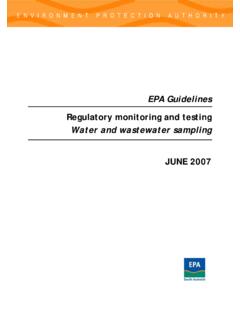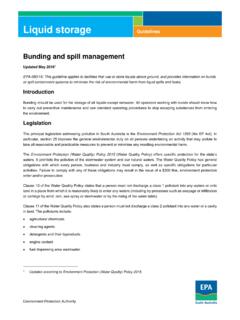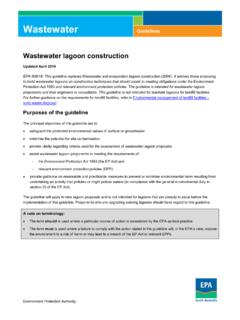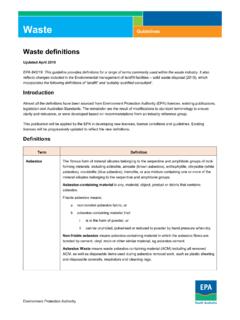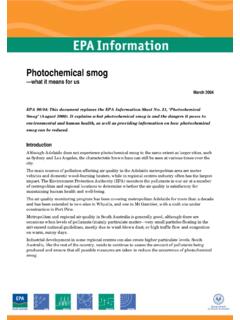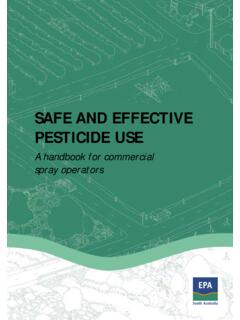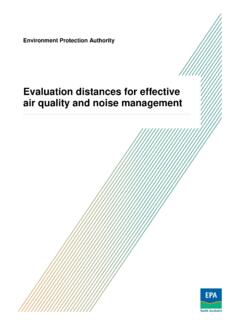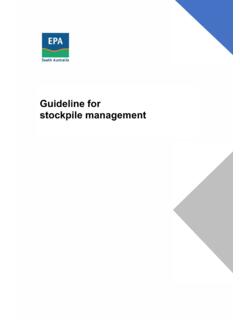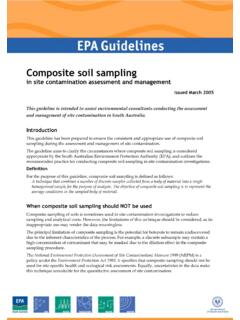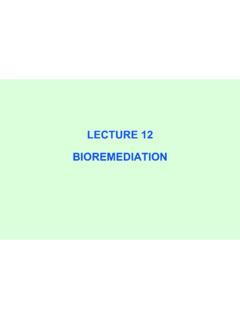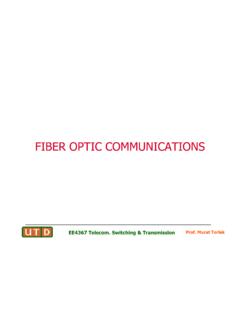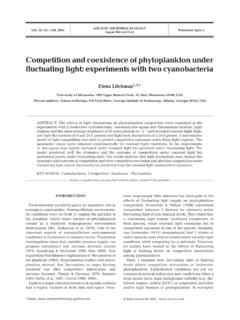Transcription of Guidelines for the assessment and remediation of site ...
1 Environment Protection Authority South Australia Guidelines for the assessment and remediation of site contamination Guidelines for the assessment and remediation of site contamination For further information please contact: Information Officer Environment Protection Authority GPO Box 2607 Adelaide SA 5001 Telephone: (08) 8204 2004 Facsimile: (08) 8124 4670 Free call (country): 1800 623 445 Website: Email: ISBN 978-1-921495-55-7 Issued July 2018 Updated October 2018 Revised November 2019 Disclaimer This publication is a guide only and does not necessarily provide adequate information in relation to every situation. This publication seeks to explain your possible obligations in a helpful and accessible way. In doing so, however, some detail may not be captured. It is important, therefore, that you seek appropriate advice regarding your obligations, including legal advice.
2 Environment Protection Authority This document may be reproduced in whole or part for the purpose of study or training, subject to the inclusion of an acknowledgment of the source and to it not being used for commercial purposes or sale. Reproduction for purposes other than those given above requires the prior written permission of the Environment Protection Authority. Contents 1 Summary .. 3 Part 1 Roles and responsibilities .. 5 1 Introduction .. 6 site contamination .. 6 6 Application of the guideline .. 7 Application of national and international publications .. 7 Currency of this guideline .. 7 National Environment Protection ( assessment of site Contamination) Measure 1999 .. 8 Protection of the environment during assessment and 8 2 EPA regulation and administration of site contamination.
3 10 The role of the 10 Selection and implementation of regulatory instruments .. 10 site contamination 11 site contamination consultants .. 12 Landowners and 12 12 Planning authorities .. 12 Preparation of reports and honesty in 13 Part 2 Legislative and policy framework .. 15 3 Determination of site 16 Overview .. 16 16 site contamination at a 17 Determination of site 17 Application of EPA recognised 18 4 Groundwater and environmental 20 Definition of water .. 20 Environmental values of 20 Process to determine environmental values of 20 5 Notification 24 Section 83A Notification of site contamination of underground 24 Hazardous 24 Part 3 assessment and auditing .. 27 6 assessment and 28 Overview .. 28 Characterising the source .. 28 Conceptual site model.
4 28 Tiered-risk assessment process .. 29 Reasons for a site contamination 32 site sampling and site 33 Part 4 remediation .. 35 7 Framework for 36 Introduction .. 36 36 Determining when remediation is necessary .. 36 remediation of sources and chemical 37 8 Development of a 38 Overview and remediation hierarchy .. 38 remediation goals .. 38 remediation 39 Optimisation of remediation strategy .. 40 Preparing a remediation options 40 Practicability 41 remediation 42 9 remediation reporting 43 Overview .. 43 remediation options assessment (ROA).. 43 site remediation plan (SRP) .. 43 remediation validation report (RVR) .. 43 site management plan (SMP).. 44 10 Groundwater remediation technologies .. 46 Application of remediation 46 remediation of non-aqueous phase liquids (NAPL).. 46 Management remediation option monitored natural attenuation (MNA) .. 47 11 Management and protection of the 48 General environmental 48 Waste management 48 Work health and safety.
5 48 Surface 48 Aesthetics .. 49 49 Asbestos .. 50 Acid sulfate soils .. 51 Part 5 Community engagement and 53 12 Community engagement and risk 54 Introduction .. 54 Key principles of risk management .. 54 Informed consent .. 54 13 Access to site contamination 56 EPA Public 56 Form 1 statements and Section 7 enquiries .. 57 Advice regarding 57 Currency of reports .. 57 EPA contact information .. 58 14 59 Appendix 1 Honesty in reporting declaration .. 63 Appendix 2 EPA recognised 66 Appendix 3 Section 83A Notification of site contamination that affects or threatens underground water .. 68 Appendix 4 Notification of hazardous circumstances .. 76 Appendix 5 assessment reporting checklist .. 80 Appendix 6 remediation reporting 91 Appendix 7 Environmental aspects for consideration when undertaking 95 Appendix 8 References for legislation and Guidelines .
6 101 Appendix 9 Electronic format of notifications and reports .. 103 List of figures Figure 1 Key considerations for the determination of the existence of site contamination at a 18 Figure 2 Process to determine environmental values of groundwater at a site .. 20 Figure 3 Summary of the site contamination tiered risk assessment process .. 30 Figure 4 Relevant schedules of the ASC NEPM documenting the tiered risk-based approach to assessment .. 31 List of tables Table 1 Application of the WQEPP to determine protected environmental values of groundwater .. 21 Table 2 Application of a buffer distance for protection of surface waters .. 21 Table 3 Application of WaterConnect (groundwater data) to determine environmental values of groundwater .. 22 Table 4 EPA recognised criteria and environmental values of groundwater .. 23 Table 5 Hazardous circumstances recommended notification, timeframes and emergency contact information .. 24 Table 6 Circumstances when the EPA may require an audit for a Table 7 Key considerations during site sampling and site activities for collection of reliable data.
7 33 Table 8 Selection of the remediation options to inform the preparation of the 41 Table 9 EPA recognised criteria for human health and ecological receptors .. 66 Table 10 Environmental values of waters and EPA recognised criteria .. 67 CVI Abbreviations ACM asbestos-containing materials ANZG Australian & New Zealand Guidelines for Fresh & Marine Water Quality (2018) ASC NEPM National Environment Protection ( assessment of site Contamination) Measure 1999 (as amended 2013) AWQG Australian W ater Quality Guidelines CEMP construction environment management plan COI chemicals (substance) of interest CSM conceptual site model chlorinated hydrocarbon vapour intrusion DEW Department of Environment and W ater DNAPL dense non-aqueous phase liquid DOM domestic registered groundwater wells/bores DQO(s) data quality objective(s) DSI detailed site investigation EIL ecological investigation level (refer to Schedule B1 of the ASC NEPM)
8 EMP environmental management plan EPA South Australian Environment Protection Authority EP Act Environment Protection Act 1993 EPO environment protection order EPP environment protection policy ERD Court Environment, Resources and Development Court (SA) ESL ecological screening level (refer to Schedule B1 of the ASC NEPM) EV environmental value GIL groundwater investigation level (refer to Schedule B1 of the ASC NEPM) GME groundwater monitoring event GMMP groundwater monitoring and management plan GMRRW Guidelines for Managing Risks in Recreational Water, 2008 GPA groundwater prohibition area GR guideline recommendation HIL health investigation level (refer to Schedule B1 of the ASC NEPM) HSL health screening level (refer to Schedule B1 of the ASC NEPM) IND industrial registered groundwater well/bore INV investigation registered groundwater well/bore IRR irrigation registered groundwater well/bore ISO International Organisation of Standards 1 ITRC Interstate Technology and Regulatory Council (US) LBSC Act Land and Business (Sale and Conveyancing) Act 1994 LBSC Regulations Land and Business (Sale and Conveyancing) Regulations 2010 LNAPL light non-aqueous phase liquid LOR limit of reporting ML management limit (refer to Schedule B1 of the ASC NEPM) MNA monitored natural attenuation MON monitoring registered groundwater well/bore NAPL non-aqueous phase liquid NHMRC National Health and Medical Research Council NRMMC natural Resource Management Ministerial Council (Australia)
9 PAHs polycyclic aromatic hydrocarbons PCA potentially contaminating activity PID photo-ionisation detector PSI preliminary site investigation PVI petroleum hydrocarbon vapour intrusion QA/QC quality assurance/quality control Regulations Environment Protection Regulations 2009 ROA remediation options assessment RVR remediation validation report SAQP sampling and analysis quality plan SCAO site contamination assessment order SMA special management area SMP site management plan SRO site remediation order SRP site remediation plan SSRA site -specific risk assessment UCL upper confidence limit VI vapour intrusion VOC(s) volatile organic compound(s) VOCC(s) volatile organic chlorinated compound(s) VSCAP voluntary site contamination assessment proposal VSRP voluntary site remediation proposal WQEPP Environment Protection (Water Quality) Policy 2015 2 Summary The South Australian Environment Protection Authority (EPA) has issued this guideline to describe the legislative and policy approach to risk-based assessment and remediation of site contamination in South Australia.
10 This guideline has been prepared for site contamination consultants (consultants), certified practitioners and site contamination auditors (auditors) undertaking the assessment and remediation of site contamination. This guideline supports the Objects of the Environment Protection Act 1993 which requires the establishment of processes for carrying out assessments of known or suspected site contamination and, if appropriate, remediation of sites. The purpose of this guideline is to provide information to assist consultants and auditors to adopt a consistent and compliant interpretation of relevant legislation, policy and guidance. This guideline also provides information to ensure the assessment and remediation of site contamination is conducted to an appropriate standard in South Australia. The EPA has prepared information in this guideline to assist consultants and auditors to: determine of the existence of site contamination using EPA recognised criteria assess and identify the environmental values of water (groundwater) using a four-step process determine when to notify of site contamination that affects or threatens underground water (section 83A of the Environment Protection Act 1993) identify matters that represent hazardous circumstances, with respective timeframes for the management of such matters undertake the assessment of site contamination in general accordance with the National Environment Protection ( assessment of site Contamination) Measure 1999 (as amended in 2013)
